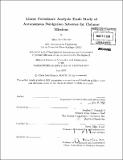| dc.contributor.advisor | Stephen C. Paschall II and David W. Miller. | en_US |
| dc.contributor.author | Kremer, Alison Sara | en_US |
| dc.contributor.other | Massachusetts Institute of Technology. Dept. of Aeronautics and Astronautics. | en_US |
| dc.date.accessioned | 2009-10-01T15:43:56Z | |
| dc.date.available | 2009-10-01T15:43:56Z | |
| dc.date.copyright | 2007 | en_US |
| dc.date.issued | 2007 | en_US |
| dc.identifier.uri | http://hdl.handle.net/1721.1/47795 | |
| dc.description | Thesis (S.M.)--Massachusetts Institute of Technology, Dept. of Aeronautics and Astronautics, 2007. | en_US |
| dc.description | Includes bibliographical references (p. 175-177). | en_US |
| dc.description.abstract | Deep space missions to the Moon and Mars under NASA's Constellation Program are a tangible goal. However, the Deep Space Network (DSN) antennas which provided ground based navigation state updates to spacecraft of the Apollo era are aging and overtaxed. The over-reliance on this ground based system for high accuracy navigation of deep space vehicles presents a distinct challenge. One viable solution to this dilemma is the application of autonomous navigation for deep space vehicles. This thesis investigates the problem of autonomous navigation by conducting a linear covariance analysis trade study on various configurations of autonomous sensors for a representative cislunar mission. The sensor suite is comprised of twelve sensors of varying measurement types and levels of flight readiness: MIMU IMU, LN200 IMU, star tracker, Inertial Stellar Compass (ISC), lunar orbiting beacon (Navsat), lunar ground beacons (Navsites), LIDAR, known lunar landmarks, SkyMark, TDRS, and GPS. A complete formulation of the linear covariance tool (LINCOV) dynamics and mathematical models of the sensors are presented. The primary focus of the study is a scenario based analysis of the navigation position, velocity, and attitude error covariances along the Moon to Earth trajectory for a specified set of sensor configurations. Major trends and observations from the lunar and Earth region navigation error covariances are discussed. Additionally, a short series of sensitivity tests on the sensor error model parameters, measurement geometry, and system process noise were conducted, providing notable insight and incentive for further studies. The conclusions of this trade study point to a promising future for autonomous space navigation. | en_US |
| dc.description.statementofresponsibility | by Alison Sara Kremer. | en_US |
| dc.format.extent | 177 p. | en_US |
| dc.language.iso | eng | en_US |
| dc.publisher | Massachusetts Institute of Technology | en_US |
| dc.rights | M.I.T. theses are protected by
copyright. They may be viewed from this source for any purpose, but
reproduction or distribution in any format is prohibited without written
permission. See provided URL for inquiries about permission. | en_US |
| dc.rights.uri | http://dspace.mit.edu/handle/1721.1/7582 | en_US |
| dc.subject | Aeronautics and Astronautics. | en_US |
| dc.title | Linear covariance analysis trade study of autonomous navigation schemes for cislunar missions | en_US |
| dc.type | Thesis | en_US |
| dc.description.degree | S.M. | en_US |
| dc.contributor.department | Massachusetts Institute of Technology. Department of Aeronautics and Astronautics | |
| dc.identifier.oclc | 428980318 | en_US |

